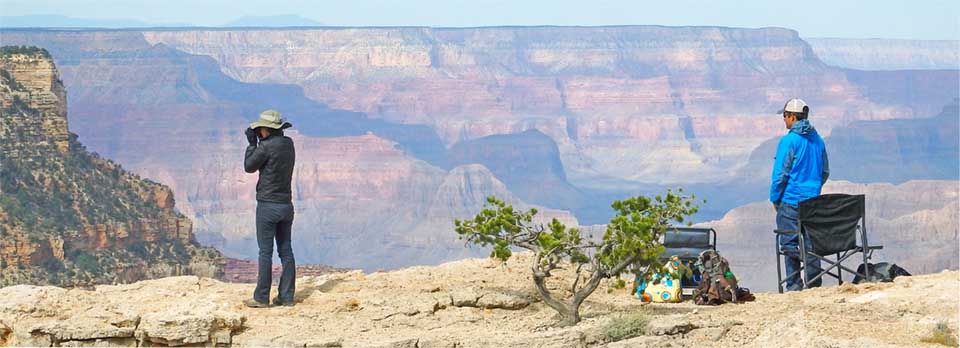
The sun is bright in late September, but the northwest breeze remains cool at Yaki Point. Tiny clouds drift by and a half moon hangs in the west over Mather Point, where the Visitor Center is hidden in the junipers. To the left, tiny hikers make their way up and down the North Kaibab Trail, and to the right, the full expanse of the Grand Canyon displays its silent face.
Here in the Pipe Creek side canyon, between the two Points, binoculars scan the sky and the far cliffs unceasingly for southbound hawks. A slight haze over the north rim and the desert to the west doesn't interfere with the eagle eyes (they would snort at this expression) of Casey, Kumara, and Ben. It's just another day for the three canyon volunteers in the 2016 Hawk Watch.
The far-away train whistle announces midday is near. A Cooper's Hawk flies across, far, fast and straight as an arrow. Identification under these circumstances is not easy, but Ben has it covered.
"I hate it when they do that," he smiles.
Ravens use the breeze and the thermals to do physical comedy routines. They fake falling out of the sky, do somersaults without losing position. This side canyon pinches the wind into a corner, increasing its power, like the tide at a rip line – add in the thermals and it can be effortless for a bird to gain altitude here. Hawks will watch the local Ravens and Turkey Vultures to determine when and how the thermals are behaving.
"There's a Kestrel rising fast on the Coconino." Casey picks out a tiny raptor, using the geologic layers a mile across the canyon so the others can confirm her sighting. Ben and Kumara raise their binoculars. I see nothing. In this casual atmosphere, great skill, attention, and expertise are brought to bear. Vital research is accumulated, one hour and one hawk at a time, research that will tell us, through fluctuations in raptor populations, whether significant changes are occurring in the ecosystem all the way down to how the amount of rainfall affected the flora. Fifteen visitors, some serious birders with scopes and long black telephoto lenses, are spread around the gleaming Kaibab limestone overlook. The crowd is on the lookout for cool birds, rare sightings. No Golden Eagles are due yet, but Ben says one day five minutes before they packed it up, both a Ferruginous Hawk dark phase and a Broad-Winged Hawk dark phase both came by. Both extremely rare. Made the whole day worth it.
Another time a Vaux's Swift, a tiny creature of the northwest skies, passed through at 5 PM. You never know. Much of the mystery of bird migration slips by us in the night, riding some storm. Author and naturalist Edwin Way Teale once got permission to hang around the top of the Empire State Building all night, just to hear and feel the wings going by. The raptors, at least, are out here when the sun is high.
"Yesterday we had a lot of Kestrels. That's a good sign. They're a species in decline. We had six go by at one time." About midway through the Hawk Watch time period, the watchers are a bit ahead of last year's count – 2,646 raptors so far, an average of 66 a day. Eight times a week, they take turns giving a presentation to canyon visitors at the Point.
Kumara: "Oh, those Sharpshins are fighting! A male and a female." The conversation can get both technical and artistic. Books are passed around, suggested. Descriptions pass over the heads of non-birders like me.
A thousand years ago, Puebloans may have looked up from winter preparations on this spot and watched the slow parade of birds pass overhead. They left pictures of them on the rock walls. The beauty and power of raptors still thrills us. Here at Yaki Point in the Grand Canyon many days of contemplative watching and careful counting, days full of hawks, are still to come.
Hawkwatch Programs: Fall 2017 (Through October 31)Come hawk watch with us! Learn how to identify raptors. Help observe and record species, sex, age, color morph and behaviors of seasonal migrant raptors.
Fri, Sat, Sun, Mon 10:45 am & 2:30 pm at Yaki Point on the South Rim. To access Yaki Point, take the free Orange Route Shuttle from the Visitor Center.
Return to Inspiration Point Blog Index Page.
This blog is meant to encourage awareness and thoughtfulness about the Grand Canyon, one of our most precious resources. It is not merely a story of what happens or has happened here, not a cookbook for what you should make of it yourself, but more an example of the many-faceted inspiration the Canyon nurtures in an artist, perhaps in you. Indeed, inspiration may be the Canyon's greatest resource.
These words are sincere, my own take on this world, deliberately non-academic and directed toward users of social media. In no way does it represent the policies or opinions of the National Park Service, although it is done under the auspices of that entity, but is offered in gratitude, with my respect and admiration for these soldiers of conservation. George H. Jacobi 2016
